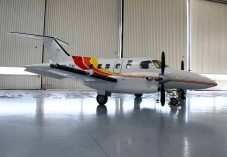Tue, Aug 11, 2009
First Pressurized Airplane Produced By The company Was
Certified 30 Years Ago
As part of the Embraer’s 40th anniversary commemorations,
the company performed a careful restoration of the EMB 121 Xingu
prototype, tail number PP-ZXI, which was the first pressurized
airplane built by Embraer. The restoration work was carried out by
students from the National Industrial Apprenticeship Service
(Serviço Nacional de Aprendizagem Industrial – SENAI)
in São José dos Campos, Jacareí, and
Taubaté, under the supervision of Embraer personnel. After
being displayed for Company employees, the aircraft will be on
permanent exhibit at the Aerospace Museum (MUSAL), in Rio de
Janeiro.

In 2009, the EMB 121 Xingu, of which 105 were built, celebrates
the 30th anniversary of its certification. This initiative
continues the process of restoring Embraer aircraft that began in
2008 with the second prototype of the Bandeirante. The airplane was
originally designed and built by the then-Aeronautical Technical
Center (Centro Técnico de Aeronáutica – CTA),
now the Aerospace Technology General Command, leading to the
founding of Embraer, on August 19, 1969. The same work was done on
both prototypes of the CBA 123, in 2009. “It has been a
unique opportunity to be able to restore Embraer’s historic
aircraft,” explains Pedro Ferraz, Director of the Embraer
Education and Research Institute. “The Xingu PP-ZXI flew for
the first time on October 22, 1976, and is different from the other
models that were manufactured. Following its validation, the cabin
of this airplane as lengthened, in order to accommodate more
passengers, and received more powerful engines. However, this
version was never produced in series.” Coordinated by
technical leaders from Embraer, the students from SENAI dedicated
themselves to the project simultaneously to their academic
studies.

The activities involved instruction, training, and oversight of
the students who acquired knowledge regarding aircraft
manufacturing, assembly techniques, and the use of
specialized tools. During the restoration process, several parts of
the fuselage, cabin, and wings needed to be rebuilt with composite
materials.
More News
Aero Linx: JAARS Nearly 1.5 billion people, using more than 5,500 languages, do not have a full Bible in their first language. Many of these people live in the most remote parts of>[...]
'Airplane Bounced Twice On The Grass Runway, Resulting In The Nose Wheel Separating From The Airplane...' Analysis: The pilot reported, “upon touchdown, the plane jumped back>[...]
"Burt is best known to the public for his historic designs of SpaceShipOne, Voyager, and GlobalFlyer, but for EAA members and aviation aficionados, his unique concepts began more t>[...]
"Polaris Dawn, the first of the program’s three human spaceflight missions, is targeted to launch to orbit no earlier than summer 2024. During the five-day mission, the crew >[...]
There Are SO Many Ways To Get YOUR Aero-News! It’s been a while since we have reminded everyone about all the ways we offer your daily dose of aviation news on-the-go...so he>[...]
 ANN's Daily Aero-Linx (05.04.24)
ANN's Daily Aero-Linx (05.04.24) NTSB Final Report: Quest Aircraft Co Inc Kodiak 100
NTSB Final Report: Quest Aircraft Co Inc Kodiak 100 Aero-News: Quote of the Day (05.04.24)
Aero-News: Quote of the Day (05.04.24) Aero-News: Quote of the Day (05.05.24)
Aero-News: Quote of the Day (05.05.24) Read/Watch/Listen... ANN Does It All
Read/Watch/Listen... ANN Does It All




